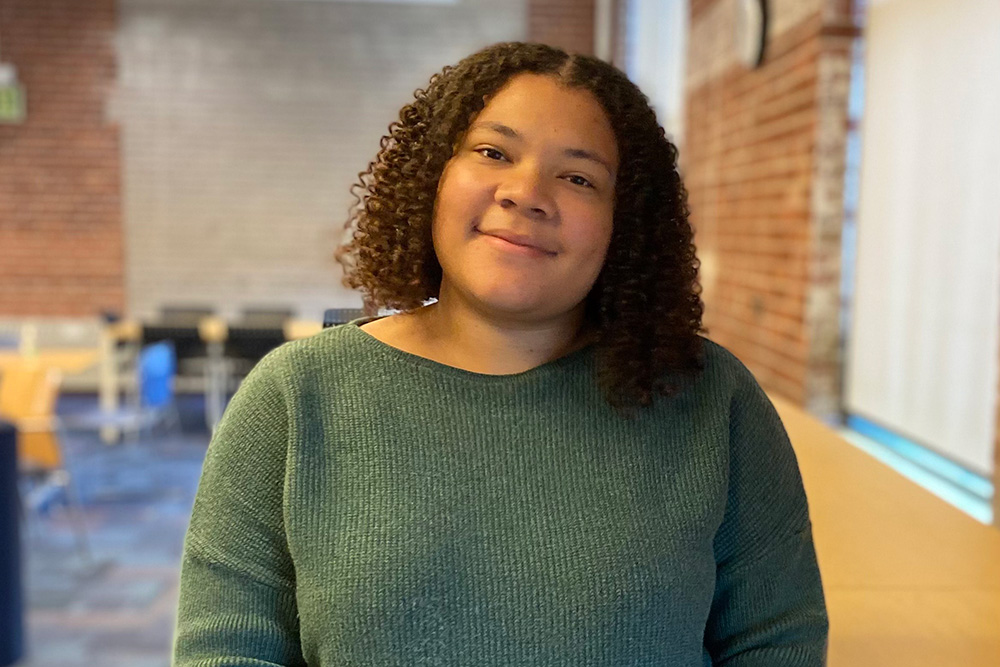Undergrad students turn innovative ideas into real solutions
Student Research Showcase exemplifies enriched experiential learning opportunities
September 7, 2017

From artificial intelligence applications in the classroom to building a better transit system in the Golden Horseshoe, undergraduate students at the University of Ontario Institute of Technology (UOIT) are brimming with brilliant ideas to make our world a better place.
On August 24, dozens shared their discoveries and findings with fellow students, faculty members, industry partners and the community at the university’s annual Student Research Showcase (SRS). The SRS offers a compelling opportunity for students to play key roles in research projects, from investigating and interviewing to data analysis and modelling.
Related links: Local media coverage of SRS
- Metroland News (August 29, 2017)
- Oshawa Express (August 30, 2017)
SRS participants presented posters summarizing their work, offering practical ideas in a wide range of research areas. Faculty members, university instructors and external judges evaluated the posters and presented awards for each faculty. About 70 per cent of projects received funding through:
- The Natural Sciences and Engineering Research Council of Canada (NSERC) Undergraduate Student Research Awards (USRA)
- The university’s Student Training Assistantships in Research (STAR) Awards program.
To help sharpen their presentation skills, participants watched a presentation by a recent participant of the university’s 2017 Three Minute Thesis competition (organized annually by the university’s School of Graduate and Postdoctoral Studies). They also heard from Langis Roy, PhD, SGPS Dean, and featured SRS guest speaker Barbara Perry, PhD, Professor with the university’s Faculty of Social Science and Humanities. Dr. Perry is a leading international research expert on hate crime and extremism. She spoke about the Challenges and Rewards of Qualitative Research.
Quote
“The University of Ontario Institute of Technology believes the opportunity for undergraduate research is a vital component of the student experience. It builds on their sound academic foundation, while providing hands-on learning to develop critical-thinking, communication and professional skills. The annual Student Research Showcase highlights the excellence of the contributions our students are making to the university’s overall research portfolio.”
-Jennifer Freeman, Director, Office of Research Services, University of Ontario Institute of Technology
Selected project profiles
- Allison Jones, Faculty of Science
Allison Jones, Comprehensive Chemistry, Faculty of Science
Poster: Design and Development of a Nanomaterial and Nanotechnology Laboratory for Fourth-Year Undergraduate Chemistry Students
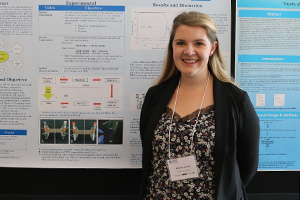
I created a YouTube video for a fourth-year undergrad chemistry lab. The course doesn’t have a lab component, so we thought an online video could help demonstrate the hands-on learning aspects of nanotechnology. Our video demonstrates a solution of equally suspended particles turned into a gel by introducing a catalyst. You can watch cool science happen rather than just reading about it in a textbook. Online learning enhances accessibility to science and can help widen the student audience.
- Spencer Lamash, Faculty of Engineering and Applied Science
Spencer Lamash, Electrical Engineering, Faculty of Engineering and Applied Science (represented the Faculty of Business and Information Technology in the 2017 SRS)
Poster: What Your Brain Says About Your Password
Co-researchers: Ruba Alomari, Shane MacDonald, Ramiro Liscano, PhD (Faculty of Engineering and Applied Science) Amit Maraj
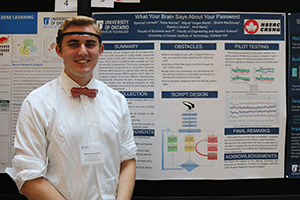
Our team examines the memorability of passwords, using a brain-computer interface headset that records brain signals. Electroencephalogram (EEG) signals determine what goes on in your brain when choosing passwords and seeing how easily memorable they are. The research goal is to generate passwords that are memorable for the user. Future brain-computer interfaces may eventually become more portable and easier to use, perhaps even in the form of eyeglasses, where there are applications for considerations like advertising.
- Michael Lombardo, Faculty of Science
Michael Lombardo, Computer Science, Faculty of Science
Poster: Exploratory Data Analysis on Student Retention
Co-researcher: Riley Weagant

We are creating a visualization/dashboard tool for the university’s Office of the Registrar (RO) to use as a commercial product to uncover why some students drop out of university before completing a four-year program. We are not trying to determine if a particular course or instructor hinders a student’s success. Rather, we are creating dashboard filters to isolate year of study, class timeslots, grade distributions and more. If we can uncover reasons for problems with success, the university can employ retention strategies. Keeping students in school also helps the university maintain tuition revenue.
- Atiya Nova, Faculty of Business and Information Technology
Atiya Nova, Game Development, Faculty of Business and Information Technology
Poster: It's All About Control: Redesigning Game Interaction Across Platforms and Controllers
Co-researchers: Samantha Stahlke and Brianne Stephenson
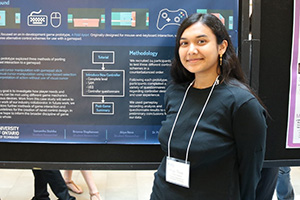
With there being so many different kinds of gaming platforms, each with unique mechanics, game designers have to consider things like hardware design and player expectations. We examined how these factors interact to create novel game-control designs. We partnered with Lightning Rod Games and used one of their in-development games as a prototype. Using a game pad, we had people test different control schemes. Our research determined the designs players were comfortable with and their expectations. In the long term, we hope to create guidelines for game control design.
- Adaobi Obua, Faculty of Science
Adaobi Obua, Pharmaceutical Chemistry, Faculty of Science
Poster: Synthesis of Terpyridine Ligands for Electrochromic Devices
Co-researchers: Nadia Laschuk, Iraklii Ebralidze and Jade Poisson
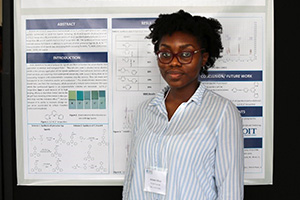
There’s a lot of industrial interest in electrochromic devices used for ‘smart windows’: mirrors in cars. We are examining how certain organic metallic synthesized substances (ligands) placed on windows will reduce brightness and glare from the outside. This would remove the need to use blinds for the same purpose. There are glare-reducing applications as well for organic light-emitting diode (OLED) televisions. Companies like Boeing are also interested in applications for aircraft, to pilots and passengers fly with greater visual comfort.
- Tyler Simcoe, Faculty of Energy Systems and Nuclear Science
Tyler Simcoe, Faculty of Energy Systems and Nuclear Science
Poster: Electrification Resiliency for GO Rail Network
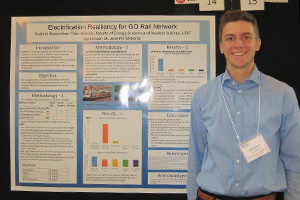
Transit authority Metrolinx is planning for the electrification of mass transit railways in the Greater Toronto Area on GO Transit. I’m investigating the consequences of a potential power grid failure and different ways to keep the trains running or get passengers to their destination.
The following organizations were on site to provide information to students about funding programs and the entrepreneurial opportunities available to them:
External participants:
- Mitacs Canada: Partnership builder between academia, industry and the world-—to create a more innovative Canada.
- Natural Sciences Research Council of Canada (NSERC): Invests in scientific discovery and people for the benefit of Canada-—science and engineering at the frontier of knowledge.
- Ontario Centres of Excellence: Accelerates innovation through game-changing research leading to successful commercialization and vibrant collaboration between industry and academia helping to launch the next generation of products and jobs.
Internal participants:
- Brilliant Entrepreneurship (supported by FastStart and Firefly)
- School of Graduate and Postdoctoral Studies
Background information:
- The SRS supported by the university’s Office of Research Services and hosted by the Office of the Vice-President Research, Innovation and International.
- The university provides both undergraduate and graduate students with an enriched and distinctive learning experience that comes from being part of a dynamic research community.
- The university recognizes the opportunity to take part in research and share in critical discoveries at an early stage of student development is an important aspect of the university experience.
- More than 85 per cent of our undergraduate students participate in experiential learning opportunities offered at the university.
Additional resources:


